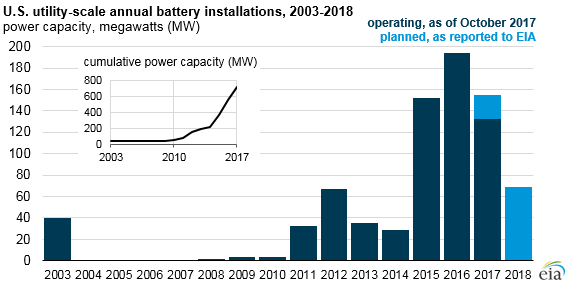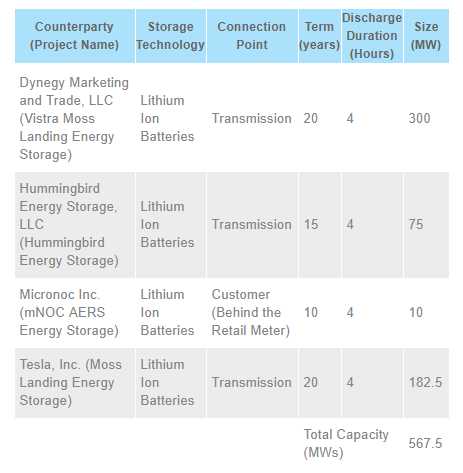Measuring Battery Electric Storage System Capabilities
by Bob Shively, Enerdynamics President and Lead Facilitator
Utility announcements of new grid battery installations are becoming common. According to the Energy Information Administration, almost 700 MW of utility-scale batteries were in operation at the end of 2017:

Source: https://www.eia.gov/todayinenergy/detail.php?id=34432
Growth in installations is expected to continue with prices declining and use cases being proved through early project data. For example, PG&E recently issued a press release announcing it has requested California Public Utilities Commission (CPUC) approval of 567 MW of storage listed in the following table:

A difficulty in reading announcements is that the capability of batteries can be measured in different ways, making it hard to understand different projects. The key quantities you need to know are as follows:
- Power capacity or power rating: The maximum amount of power that a battery can instantaneously produce on a continuing basis. It can be compared to the nameplate rating of a power plant. Power capacity or rating is measured in megawatts (MW) for larger grid-scale projects and kilowatts (kw) for customer-owned installations.
- Energy storage capacity: The amount of energy that can be discharged by the battery before it must be recharged. It can be compared to the output of a power plant. Energy storage capacity is measured in megawatt-hours (MWh) or kilowatt-hours (kWh).
- Duration: The length of time that a battery can be discharged at its power rating until the battery must be recharged.
The three quantities are related as follows:
Duration = Energy Storage Capacity / Power Rating
Suppose that your utility has installed a battery with a power rating of 10 MW and an energy capacity of 40 MWh. Using the above equation, we can conclude that the battery has a duration of 4 hours:
Duration = 40 MWh / 10 MW = 4 hours
This means that if the battery is fully charged, and discharged at its maximum power rating, it will provide energy for four hours before needing a recharge. Of course, if it is discharged at less than its maximum rating, it could provide energy for a longer period of time.
So now when you read a battery announcement, you can understand what the numbers mean!
Back to blog home page